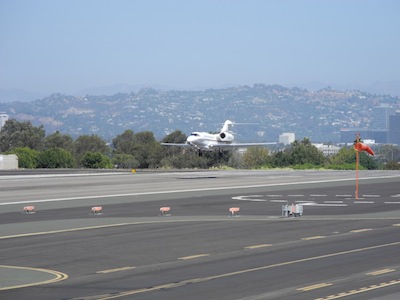SANTA MONICA—The Mar Vista community bordering the Santa Monica Airport (SMO) scored poorer air quality levels than areas in downtown Los Angeles and far worse than its Santa Monica neighbors, UCLA researchers found.
The study published in the December issue of “Atmospheric Environment” expanded upon prior research showing regional differences in air quality by revealing that differences could also be found at the neighborhood level.
UCLA researchers selected neighborhoods from two regions of Los AngelesCounty to compare how levels of air pollution differed from one another. Using an emissions-free electric vehicle, researchers took real-time air pollutant samples from the West Los Angeles region, including the North Westdale neighborhood of Mar Vista, the downtown Los Angeles region and the downtown community of Boyle Heights.
The study, titled “Neighborhood-scale air quality impacts of emissions from motor vehicles and aircraft,” primarily focused on measuring ultrafine particles that come from freshly emitted pollutants. These ultrafine particles are the tiniest type of airborne pollutant, measuring less than 0.1 microns in diameter, and are primarily pumped into the air by tailpipe emissions.
“Ultrafine particle pollutants have been receiving more attention recently from the scientific community,” Professor Paulson of UCLA’s Atmospheric and Oceanic Sciences Department and Institute of the Environment and Sustainability told the Canyon News.
According to the U.S. Environmental Protection Agency’s (EPA), ultrafine particles of pollution “have widespread deposition within the respiratory tract” and therefore causes “concern that there may be adverse health effects associated with exposure to ultrafine particles.”
“The effects are all based on proximity to roadways,” explained Professor Paulson. This means that the closer a person is to a tailpipe’s emissions, the more acute the health effects of breathing the pollution are likely to be.
Unlike the larger-sized fine pollution particles, the EPA does not regulate ultrafine particles. None of the roadway pollutants, besides carbon monoxide, are currently being regulated because there has not been enough scientific research yet to set a health standard, the UCLA researcher stated. There has been a growing body of research linking inhalation of these tiny toxins to increased negative health effects such as asthma, heart attacks, strokes, diabetes, low birth weight and pre-term births.
According to the study’s results, the North Westdale community had the highest concentrations of freshly emitted pollutants, followed by the high traffic areas of Boyle Heights, downtown LA and lastly, West LA.
“The North Westdale neighborhood is heavily impacted by aircraft activities at Santa Monica Airport,” said Professor Paulson, who headed the study. “It has exceptionally high levels of ultrafine particles when aircraft are active, possibly among the highest concentrations of any neighborhood in the Los Angeles area.”
North Westdale’s surrounding neighbors in the West Los Angeles region, however, scored much better air quality ratings and actually experienced a significant drop in ultrafine particle pollutants between 2008 and 2011, the study revealed. The reason is due to the relative overall affluence of Santa Monica residents, who are more likely to drive newer, more eco-friendly vehicles that produce less pollution than older vehicles.
Professor Paulson stated, “Santa Monica has plenty of traffic going on, but the traffic emissions are much cleaner,” compared to lower-income communities in downtown Los Angeles that drive a larger proportion of old, high-emission vehicles.
The case is especially true for the community of Boyle Heights, which experiences especially high concentrations of traffic pollution because it sits at a busy hub of street and major freeway intersections. Despite being part of the Santa Monica region, the North Westdale community borders so closely to the Santa Monica Airport that residents are exposed to high levels of ultrafine particles emitted by the airplanes.
Although Los Angeles’ international airport, LAX, is a much larger and busier airport, compared to SMO there is “a much larger buffer zone between the airport and the neighboring communities,” so residents living in the areas by LAX are less impacted by the planes’ emissions, Professor Paulson said.






